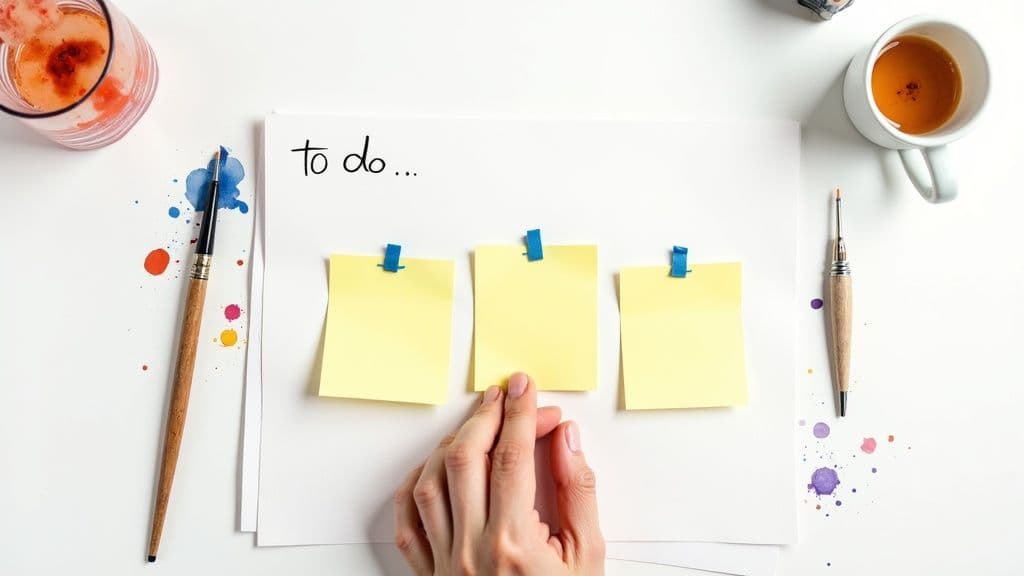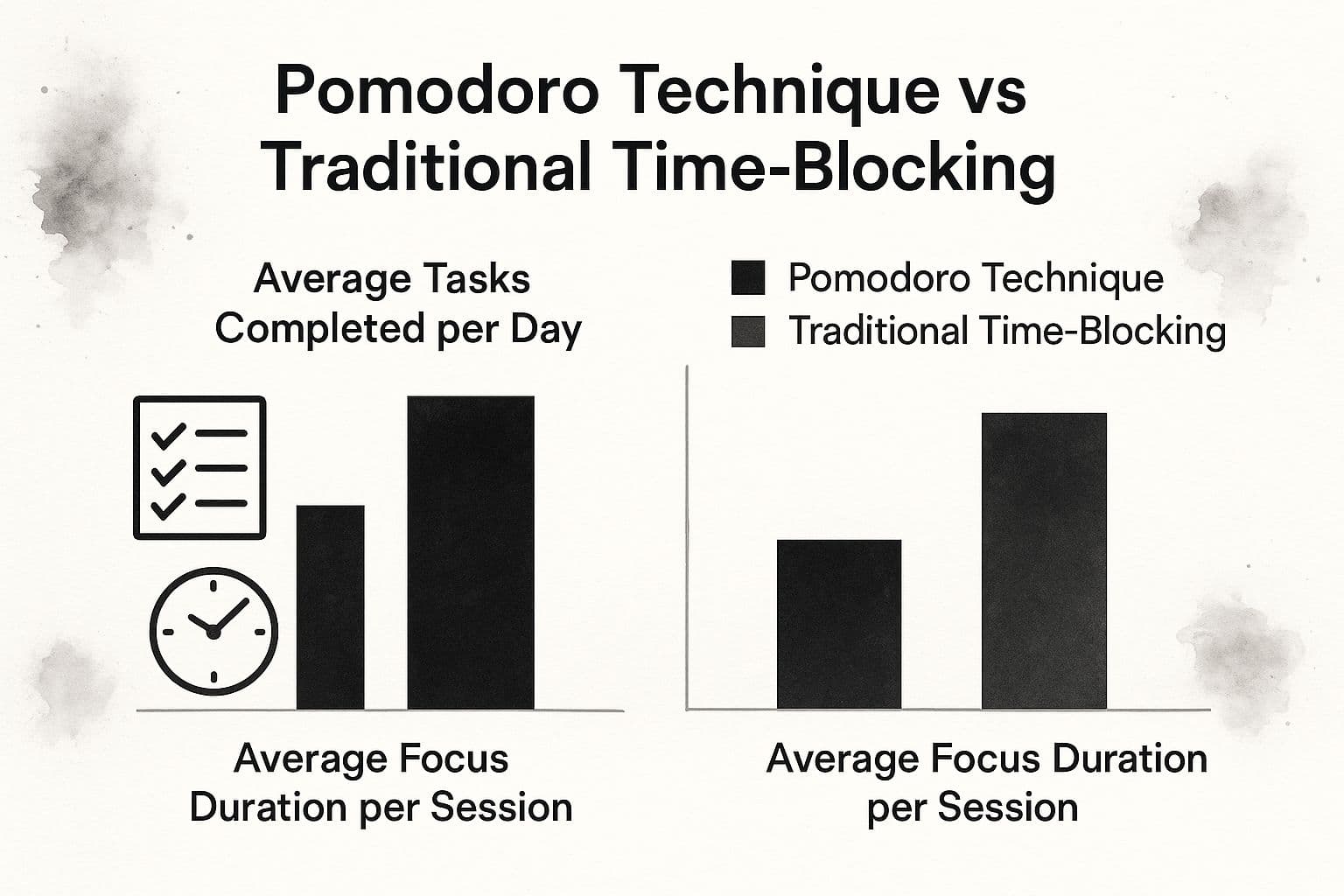Learn how to focus better at work with proven strategies to minimize distractions and boost your productivity today.
Do less, be more with Fluidwave
Fluidwave combines smart task prioritization with an assistant marketplace — AI and human help, all in one productivity app.
July 10, 2025 (4mo ago)
How to Focus Better at Work: Tips for Increased Productivity
Learn how to focus better at work with proven strategies to minimize distractions and boost your productivity today.
← Back to blog
It feels like an uphill battle just to concentrate, doesn't it? If your focus at work is constantly being hijacked, you’re not alone. The real secret to getting your attention back isn't about willpower; it’s about taking control of your environment, your to-do list, and your own energy levels. This guide is all about giving you practical, field-tested strategies you can start using right away.
Why Is It So Hard to Focus at Work?

If you feel like your entire day is a defensive game against pings, pop-ups, and "quick questions," you're experiencing the modern work dilemma firsthand. The constant digital noise, the mental whiplash of switching between a dozen apps, and a calendar packed with meetings—it’s no wonder deep, meaningful work feels almost impossible.
This isn't a personal flaw. It's a design flaw in how we work.
The numbers are pretty staggering. Research shows that many employees spend up to 60% of their workday** on things other than their core responsibilities. Think about that. More than half the day is lost to navigating complex software, searching for information, or sitting in meetings that don't move the needle. This isn’t just inefficient; it’s a massive drain on our focus.
The heart of the issue is that our work environments are built for interruption, not concentration. To get your focus back, you have to intentionally create a system that protects it.
This guide will give you a clear framework to do exactly that. We'll go beyond the usual tips and get into a structured approach for taking back control.
The Three Pillars of Sustainable Focus
To really make a dent in this problem, we've found that it helps to break it down into three core areas. Think of them as the pillars supporting your ability to concentrate. Get these right, and you'll build a resilient system for deep work that can stand up to the daily chaos.
Here's a quick look at the foundation we'll build on:
| Pillar | Core Problem It Solves | Key Action |
|---|---|---|
| Engineering Your Environment | Constant physical and digital interruptions. | Actively shape your workspace to minimize distractions and create a "focus sanctuary." |
| Controlling Your Tasks | An overwhelming, chaotic to-do list. | Use smart prioritization and delegation to ensure you're always working on what truly matters. |
| Managing Your Energy | The inevitable afternoon slump and burnout. | Align your most demanding work with your natural energy cycles to maintain peak concentration. |
By systematically improving these three areas, you can build powerful habits that defend your attention. It's an approach that not only boosts your output but also leads to more satisfying, less stressful workdays. The first pillar is so crucial that we've dedicated an entire article to it—you can get more strategies for building your focus zone in our guide on how to avoid distractions at work.
Designing a Distraction-Free Workspace
Your ability to concentrate is tied directly to what’s around you. If you’re serious about improving your focus at work, you have to start by taking a hard look at both your physical and digital environments. This goes way beyond just tidying your desk. I'm talking about conducting a full-on "distraction audit" to pinpoint exactly what pulls you off track.
A great way to begin is by simply observing yourself for a day. Keep a notepad nearby and, without judgment, make a little mark every time your focus breaks. Was it a Slack notification? A coworker stopping by your desk? An interesting headline you spotted in an open browser tab? This simple exercise will tell you exactly where your attention is leaking.
Once you know your personal focus kryptonite, you can start making real changes. You might be surprised to learn the biggest offender isn't your phone, but the chaotic state of your digital desktop.
Create a Digital Sanctuary
Let's face it: our computers are often the biggest source of interruption. A few smart adjustments, however, can turn that distraction machine into a high-performance tool for getting things done.
First, try creating dedicated spaces for different activities. For example, set up a separate browser profile just for work—no social media, no news sites, no personal email. This creates a psychological barrier that makes it surprisingly easier to stay in the zone.
Next, it’s time to get ruthless with your notifications. Go through your computer and phone settings and turn off every single non-essential alert. If an app doesn’t absolutely need to ping you for you to do your job, its notification privileges should be revoked. This goes for email pop-ups, too; they're notorious for derailing a good train of thought.
Key Takeaway: The goal isn’t to ditch technology, but to control when and how it gets your attention. You should be in charge of engagement, not your devices.
Don't hesitate to use app and website blockers during your focus blocks. Think of them not as a crutch, but as a strategic defense against the incredibly powerful algorithms designed specifically to capture and hold your attention.
Engineer Your Physical Environment
Whether you're in a loud open office or a quiet corner at home, your physical space has a massive impact on your concentration. For those working remotely, the data is pretty clear: studies show a 22% increase in deep-focus work compared to their in-office counterparts. Remote employees clock in around 22.75 hours of focused work each week, while office-based staff manage about 18.6 hours. This really underscores the power of a controlled environment. You can dive deeper into these productivity statistics to see the full picture.
If you’re in an office, noise-canceling headphones are your new best friend. They send a clear "do not disturb" signal without you having to say a word.
It also helps to be direct with your team. A quick message like, "Heads up, I'm going into a deep focus session for the next 90 minutes," can prevent a world of interruptions.
When you can, try to position your desk facing a wall or a window with a simple view. Constant movement in your peripheral vision is a subtle but significant drain on your focus. And finally, a clean, organized desk isn't just about aesthetics; it reduces visual clutter and the mental energy you spend processing it, making it that much easier to drop into and maintain deep work.
Mastering Your Tasks and Prioritizing What Matters

Let's be honest: an endless to-do list is a focus killer. When every task screams for your attention, it's impossible to know where to start. You end up feeling swamped, bouncing between low-priority emails and genuinely critical projects, and achieving very little.
If you want to truly focus at work, you have to get a handle on your tasks. This isn't about just listing what you need to do; it's about building a reliable system to decide what actually deserves your energy. The goal is to shift from being reactive—constantly putting out fires—to being proactive and intentional with your time. That's the bedrock of real concentration.
Adopt a Prioritization Framework
To cut through the noise, you need a proven method for sorting your workload. Without a system, we often let our emotions or the demands of others dictate our day. Two of my favorite frameworks for bringing order to the chaos are the Eisenhower Matrix and the MoSCoW method.
The Eisenhower Matrix is brilliant for its simplicity. It forces you to categorize every task based on its urgency and importance, which are two very different things.
- Urgent & Important (Do Now): These are your non-negotiables—true crises and hard deadlines. Think of a critical bug crashing your app for users.
- Important, Not Urgent (Schedule): This is where real progress happens. These are the strategic projects that move the needle, like planning the marketing strategy for the next quarter.
- Urgent, Not Important (Delegate): These are interruptions that feel pressing but don't require your specific expertise. A classic example is a routine request for information from another department.
- Neither Urgent nor Important (Delete): The distractions. Mindless scrolling on social media fits perfectly here.
Sorting your tasks this way brings instant clarity. You start to see what's actually important versus what's just loud. It’s a powerful mental shift that channels your energy toward high-impact work.
Another fantastic tool, especially for team projects, is the MoSCoW method. It helps you group tasks into Must-haves, Should-haves, Could-haves, and Won't-haves (for now). It’s incredibly useful for getting everyone on the same page about a project's scope. We dive much deeper into how to manage competing priorities with techniques like this in our guide.
Break Down Big Projects
Massive projects are a leading cause of procrastination. A task like "Launch New Product" on your to-do list is so huge and vague that it’s paralyzing. Where do you even begin? The trick is to atomize it. Break that intimidating goal down into the smallest possible, concrete steps.
Instead of one monster task, your project plan should look more like this:
- Draft the initial product brief.
- Schedule the kickoff meeting with the design team.
- Create a wireframe for the main dashboard.
- Write the first draft of copy for the landing page.
Each of these is a manageable task you can knock out. Checking them off creates a sense of accomplishment and builds momentum, which in turn fuels your focus for the next step. You’re not trying to climb a mountain in one leap; you’re just taking the next small step up the hill.
It’s easy to blame technology for our scattered attention, but that’s only half the story. When you’re intentional about it, the right tech can become your single greatest asset in protecting your focus. Instead of letting your digital tools pull you in a million directions, you can build a system that actively defends your time and mental energy.
Think of it this way: your digital workspace could be a finely tuned assistant rather than a source of constant chaos. This isn't about piling on more apps. It's about being selective and choosing smart tools that automate the low-value, repetitive work that drains your brainpower. Imagine using an AI tool to summarize a dense email chain in seconds—that's 20 minutes of cognitive effort you just got back for more important thinking.
The infographic below illustrates how different focus techniques, enabled by technology, can shape your workday. It’s not just about what you do, but how you structure it.

As you can see, there's a trade-off. The Pomodoro Technique might help you churn through more small tasks, but traditional time blocking is often better for sinking into those long, uninterrupted stretches of deep work. The right tool helps you commit to either method.
Build an Intelligent Tech Stack
The goal is to assemble a small, powerful suite of tools that work for you, not the other way around. A well-designed tech stack should feel like it's clearing the path ahead, handling the tedious logistics so you can stay locked in on high-impact work.
A great starting point is to identify the most mind-numbing, repetitive parts of your day. Are you still manually updating a project spreadsheet? Do you spend what feels like half your morning trying to schedule one meeting? These are perfect candidates for automation.
This is exactly where focused platforms like Fluidwave shine. It uses AI to automatically sort and prioritize your to-do list, which removes the "What should I do next?" paralysis that eats up precious mental bandwidth.
A clean, intuitive interface is also crucial. It should help you manage and delegate tasks without the visual noise and clutter that most platforms create.
Technology should be a shield that protects your focus, not a sieve that lets it drain away. The goal is to automate, delegate, and eliminate everything that stands between you and deep work.
It's no surprise that AI adoption is soaring. Projections show that by 2025, AI will be used by 58% of employees—a massive jump of 107% since 2022. This is exciting, but it also comes with a risk. Without smart implementation, it could lead to longer workdays and even more fractured attention. That’s why it’s so critical for companies and individuals to build workflows that integrate technology thoughtfully. You can discover more insights about rethinking productivity on eptura.com to see how these trends are shaping the future of work.
Tools to Help You Automate, Delegate, and Focus
Building a tech stack that protects your focus doesn't have to be complicated. The right tools fall into a few key categories, each designed to handle a different aspect of workplace distraction.
Productivity Tools for Enhanced Focus
| Tool Category | How It Boosts Focus | Example Use Case |
|---|---|---|
| Project Management | Centralizes tasks, deadlines, and communication, reducing the need to hunt for information across different apps. | Using a platform like Asana or Trello to track project progress, assign tasks, and keep all related files in one place. |
| Automation Platforms | Connects different apps to automate repetitive workflows without any manual intervention. | Setting up a Zapier "Zap" to automatically save email attachments to a specific Dropbox folder. |
| Communication Hubs | Consolidates team conversations and reduces reliance on distracting email chains. | Using a dedicated channel in Slack or Microsoft Teams for a specific project to keep all discussion focused and archived. |
| Focus & Time Blockers | Actively blocks distracting websites and apps during dedicated work sessions to enforce deep work. | Activating an app like Freedom or Cold Turkey for a 90-minute block to prevent access to social media and news sites. |
Ultimately, the best tools are the ones that fade into the background, seamlessly handling the busywork so you can stay centered on what truly matters.
Actionable Tech Strategies for Better Focus
To turn technology into an ally, you have to be deliberate. Here are a few practical ways to get started:
- Automate Ruthlessly: Look for opportunities to offload recurring tasks. Use tools to handle follow-up emails, generate weekly reports, or schedule your appointments. Every task automated is cognitive fuel saved for bigger challenges.
- Embrace Smart Delegation: Tools like Fluidwave make it easy to delegate tasks not just to team members, but to virtual assistants. This is a game-changer for offloading the small but time-consuming items that constantly break your concentration.
- Curate Your Notifications: Be the ruthless bouncer of your digital world. Conduct a "notification audit" and turn off every alert that isn't absolutely essential. For the apps that make the cut, customize the settings to batch notifications, so they arrive on your schedule, not theirs.
When you become the architect of your digital environment, you flip the script. Technology stops being a primary distraction and transforms into your most powerful productivity partner.
Manage Your Energy, Not Just Your Time

True, lasting focus has a lot less to do with sheer willpower than most people think. It's actually about biology. Your ability to concentrate is a finite resource, one that's directly powered by your physical and mental energy. Thinking you can maintain peak focus for eight hours straight is a recipe for failure. It's like asking a sprinter to maintain their top speed for an entire marathon—our brains just aren't wired that way.
If you’ve ever slammed into that 2 p.m. wall, you know exactly what this feels like. The secret to sustained concentration isn't just managing your calendar; it's about managing your energy. This means learning to work with your body's natural rhythms, not constantly fighting against them.
Ride Your Natural Energy Waves
Most of us have heard of circadian rhythms, the 24-hour cycle that controls our sleep. But what happens during the day is just as important. Our brains operate on shorter cycles called ultradian rhythms. These are natural waves of energy, typically lasting 90 to 120 minutes, where our brain can hit high-frequency activity. This is followed by a necessary 15-to-20-minute dip into lower-frequency activity.
Pushing through those natural dips is a surefire path to burnout. This is where techniques like the Pomodoro Method shine. It breaks your work into focused 25-minute sprints followed by short 5-minute breaks, essentially creating a micro-version of managing your ultradian rhythms.
For larger, more demanding tasks, you can scale this concept up. Try working in dedicated 90-minute blocks, then taking a genuine, restorative 15-minute break away from your screen. This approach helps you maintain a high level of performance all day long by preventing those deep energy slumps that kill productivity.
My Takeaway: I've found that working in focused sprints with intentional rest is far more productive than any "marathon" session I've tried to pull off. You're aligning your work with how your brain is actually built to perform.
Take Breaks That Truly Recharge You
What you do on your break matters just as much as the focused work itself. Mindlessly scrolling through a social media feed or checking news headlines might feel like a break, but it often does more harm than good. These activities are designed to capture your attention, leaving you feeling even more drained than when you started.
The trick is to take "smart breaks" that genuinely replenish your mental batteries. Here are a few things I've found that work wonders:
- Take a quick walk. Even just 5-10 minutes, especially outside if you can, gets the blood flowing and can spark new ideas.
- Practice a little mindfulness. A few deep breaths or a quick meditation can calm your nervous system and give your focus a hard reset.
- Do some light stretching. Sitting is the new smoking, right? Counteract it with gentle stretches for your neck, shoulders, and back to release built-up tension.
- Listen to one song. Put on a favorite track (I find instrumentals work best) and just close your eyes for three or four minutes.
The goal here is simple: give your prefrontal cortex—the part of your brain doing all the heavy lifting for focus and decision-making—a real chance to rest.
Fuel Your Brain Like a High-Performance Engine
Finally, let’s not forget the absolute cornerstones of energy management: sleep, nutrition, and hydration. These aren't just trendy wellness tips; they are non-negotiable requirements for anyone serious about improving their focus at work.
Even a slight lack of sleep can tank your cognitive function, attention span, and judgment. Make it a priority to get 7-9 hours of quality sleep each night. This is when your brain consolidates memories and clears out the metabolic junk that builds up during the day.
What you eat also has a direct line to your brain's performance. A lunch heavy in sugar or refined carbs will give you a quick spike followed by a productivity-destroying crash. Instead, build your meals around protein, healthy fats, and complex carbs for a slow, steady release of energy. And please, don't forget to drink water! Dehydration is one of the most common, and easily fixable, causes of brain fog. Keep a water bottle at your desk and sip on it all day.
Answering Your Toughest Focus Questions
Knowing how to improve your focus is one thing; actually doing it is another beast entirely. It’s easy to read about strategies, but the real test comes when you're up against old habits and unexpected workplace pressures.
Let’s tackle some of the most common hurdles people face when they start trying to get serious about deep work. Think of this as a field guide for troubleshooting the real-world problems that can get in your way.
What if My Boss Expects Me to Be "Always On"?
This is probably the number one concern I hear. The pressure to reply instantly can feel immense, often derailing even the best intentions for focused work. The fix isn't about ignoring your boss; it's about proactively managing expectations.
You need to have a conversation. Frame it around productivity, not unavailability. Explain that you're experimenting with time blocking to produce higher-quality work and that this involves dedicated "focus time." You can assure them you'll check messages at set intervals—say, once every 90 minutes—so nothing truly urgent gets missed.
Here's the reality: Most managers care more about results than your response time. Once you prove that these focused blocks lead to better, more efficient work, they’ll almost certainly get on board.
It’s a simple shift in framing. You’re not "going offline"—you're "optimizing my workflow to deliver better outcomes."
How Do I Get Back on Track After an Inevitable Interruption?
Let's be real: no matter how well you plan, interruptions are going to happen. A client has an emergency, a key teammate needs your input now... that's just life. The secret isn't avoiding all interruptions but preventing one from torpedoing your entire day.
When the dust settles, don't just jump straight back into your task. Take a deliberate moment to reset. I find that a simple 30-second routine works wonders. Just stand up, do a quick stretch, and take a few deep breaths. This small act creates a mental break, signaling to your brain that the interruption is over and it's time to refocus.
For more on this, our complete guide on how to focus at work has some great techniques for building the mental muscle to bounce back from these daily disruptions.
How Long Until This "Focus" Thing Feels Natural?
Building new habits is a marathon, not a sprint. The research is pretty clear: it can take anywhere from 18 to 254 days for a new behavior to become second nature. The key isn't perfection; it's consistency.
You’re going to have off days. That’s okay. The goal is steady progress. Start with something manageable, like one solid 60-minute focus block each day for a week. Once that feels comfortable, build from there.
A good progression might look something like this:
- Week 1: Master one uninterrupted focus session each day.
- Weeks 2-3: Aim for two sessions and start experimenting with structured breaks.
- Week 4 & Onward: Start fine-tuning your approach, maybe trying out different time-blocking techniques.
Every time you complete a focused session, you're strengthening your ability to concentrate. These small, consistent wins are what create lasting, sustainable habits.
Ready to stop juggling tasks and start achieving deep focus? Fluidwave uses intelligent automation and AI to prioritize your workload, delegate tasks to skilled assistants, and create a distraction-free environment where you can do your best work. Discover how Fluidwave can transform your productivity today.
Do less, be more with Fluidwave
Fluidwave combines smart task prioritization with an assistant marketplace — AI and human help, all in one productivity app.